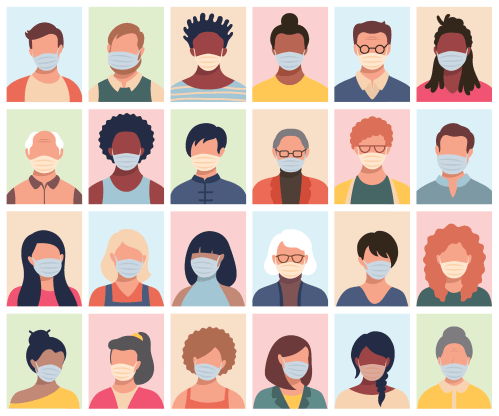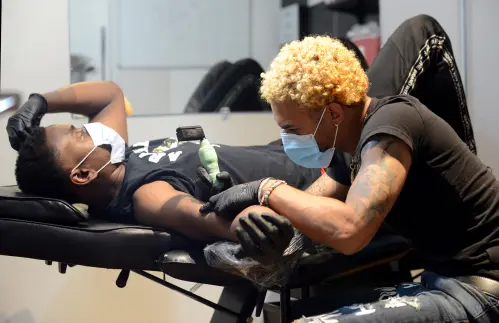Vulnerability to COVID-19 is much greater for Black Americans (see our earlier paper “Race gaps in COVID-19 deaths are even bigger than they appear”). This is because of a wide range of factors, including geography, occupation, housing conditions, and access to health care. In “Why are Blacks dying at higher rates from COVID-19?” our colleague Rashawn Ray describes these structural inequalities leading to disparate outcomes.
Differences in rates of comorbidities – health conditions that increase the risks following infection – are also a significant contributor to racial inequalities. Here we break down CDC data for three health conditions known to increase the risk associated with COVID – hypertension, obesity, and diabetes – by race and gender. All three are strongly related to diet and nutrition, and highlight the need for reform of the U.S. food system.
The prevalence of each condition varies significantly across racial groups, and between men and women in complex ways; the gender gaps differ by race and the race gaps differ by gender. The differences across groups are, in many cases, quite large. Black women, for example, are twice as likely to be severely obese (with a Body Mass Index of at least 40), at a rate of 16%, as almost every other group. Hispanic men are twice as likely to be diagnosed with diabetes as white women. Men have much higher rates of uncontrolled hypertension than women of the same race: except among Black Americans, where hypertension prevalence is for both men and women.
Hypertension
Hypertension is a leading risk factor for mortality from COVID-19. Overall, just under a third of adult Americans suffer from this condition, with higher rates among men and older people. Risk factors include high cholesterol and obesity (see below). An overview article in the journal Hypertension notes that “poor diet, physical inactivity, and excess intake of alcohol, alone or in combination, are the underlying cause of a large proportion of hypertension.” Progress has been made in recent years in controlling high blood pressure, but a large proportion remains uncontrolled, according to the CDC.
Differences by race and gender are big, however. Most striking are the higher rates for Black Americans. Two in five Black men (42%) and Black women (43%) suffer from hypertension, compared to 31% of white men and 27% of white women. There are also large race and gender gaps in the likelihood that hypertension is being controlled with medication. There are twice as many Black, Asian and Hispanic men with uncontrolled hypertension as there are with controlled hypertension, for example.
Obesity
While not a health condition in itself, obesity is related to a wide range of chronic health conditions, especially diabetes, which we turn to below. People defined as obese are also more likely to rate their own health as poor. Overall rates of obesity (with a BMI of 30+) are highest among Black women (at 57%), followed by Hispanic women (49%).
Black women have the highest risk of being severely obese (with a BMI of 40 kg/m2 or higher), at a rate of 16%, followed by Hispanic women at 10%, and white women at 9%. There are almost as many Black women falling into the morbidly obese category as into the “normal weight” category (18%, not shown).
A few additional points are worth making here on measurement. The flaws in BMI are broadly accepted in the medical and public health communities, especially in terms of making binary distinctions such as “normal weight” versus “overweight”; it is much better to think of it as a continuum. There are also much better ways to measure risks to metabolic health.
Scholars such as Sabrina Strings, author of Fearing the Black Body: The Racial Origins of Fat Phobia also draw attention to the gendered and racialized nature of many discussions of health, especially in terms of body shape and size. While we add our names to the list of critics of BMI as an objective measure of health for all people, right now BMI data is the most broadly collected reliable data. And despite its drawbacks, there is no serious doubt that a high BMI predicts poorer health overall.
Diabetes
Diabetes is a risk factor for poor outcomes from COVID-19 infection. Americans diagnosed with diabetes are likely to be either obese (46%) or severely obese (16%), according to CDC.
Again, there are wide inequities by race and gender. For diagnosed diabetes, Hispanics men are at the highest risk (14%), followed by Black women (12%), Hispanic women (12%) and Black men (11%). Whites have the lowest rates – lower in fact than Asian Americans. These health inequities show up in the geography of our cities too. In Ward 8 of Washington DC, the poorest in the city, and predominantly Black, the rate of Type 2 diabetes is 15%, for example. In Ward 3 – richest and whitest – the rate is 2%.
Nutrition: A growing divide
The COVID-19 pandemic has acted like an x-ray, exposing the breaks in our society on many dimensions. As our colleagues Molly Kinder and Tiffany Ford have shown, Black Americans especially are on the front lines, disproportionately responsible for providing essential services: saving lives, and risking their own. At the same time, the COVID-19 crisis has exposed many stark inequalities in the health of Americans that existed long before the virus reached our shores. Some light is now being shined on issues that were left in the dark for too long.
The pandemic, combined with the killing of George Floyd has led to a moment of reckoning with the structural inequalities curtailing the life chances – and the lives – of Black Americans. One of these structures is our broken food and nutrition system. Ten diet-related risk factors account for almost one in two deaths from heart disease, stroke and Type 2 diabetes—around 1,000 deaths each day.
As three of the leading diet and nutrition scientists Dariush Mozaffarian, Kenneth Rogoff and David Ludwig, write:
“Suboptimal diet quality is the leading factor associated with death and disability in the US and globally. Presently, strategies to address suboptimal diet focus on nutrition education through dietary guidelines and food package labeling. However, this approach places responsibility for healthier diets on an individual’s ability to make informed choices, rather than addressing the complex, powerful environmental determinants of dietary habits. Not surprisingly, this strategy has fallen short, as demonstrated by the increasing rates of obesity, diabetes, and other diet-related illness.”
The trio urge concerted action to tackle our diet-driven health crisis, including a 10-30% tax on most packaged foods and chain restaurants, acknowledging that this would face “political obstacles.” In the meantime, some small steps have been taken in right direction. The 2020 Dietary Guidelines Advisory Committee’s final scientific report recommends that no more than six percent of daily energy intake should be from added sugars, down from 10% in previous guidelines.
But it is clear that bolder steps are needed here. Given the growth in chronic diseases, now afflicting more than half the population, and the clear links to diet and nutrition, a radical transformation of our food system is required – encompassing agricultural subsidies, school meals, advertising rules, tax policy, dietary guidelines, and more. If saving thousands of Black lives does not provide enough political will, now more than ever, it is hard to imagine what could.
In the above data, white, Black, and Asian do not include people of Hispanic origin.
The Brookings Institution is committed to quality, independence, and impact.
We are supported by a diverse array of funders. In line with our values and policies, each Brookings publication represents the sole views of its author(s).








Commentary
Black and Hispanic Americans at higher risk of hypertension, diabetes, obesity: Time to fix our broken food system
August 7, 2020